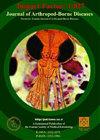黑腹果蝇实验室饲养用于基于沃尔巴克氏体的控制计划--登革热控制的一个组成部分
IF 0.6
4区 医学
Q4 PARASITOLOGY
引用次数: 0
摘要
背景:黑腹果蝇是一种操作简便、维护成本低且安全的模式生物,可毫不费力地应用于基因组学、生物技术、遗传学、疾病模型以及基于沃尔巴克氏体的方法等生命科学的不同领域,以对抗病媒及其传播的病原体。研究方法在伊朗的 25 个地区(14 个省)采集果蝇标本,并根据线粒体 COI 条形码区的序列同源性进行分子分析,以证明其形态学特征。提供了实验室饲养黑腹果蝇的基本信息和具体要求。研究结果在 25 个地区中的 23 个地区发现了黑腹果蝇群落。此外,本研究还报告了 5 个与黑腹果蝇重合的相关物种,包括 D. ananassae/D. parapallidosa、D. hydei、D. repleta、Zaprionus indianus(双翅目:果蝇科)和 Megaselia scalaris(双翅目:萤火虫科)。本文描述了伊朗 D. melanogaster 分子特征及其饲养技术。从卵到成虫的整个生命周期在 25 °C下大约需要8天。介绍了一些生物学要点,包括捕捉、饲养、培养和胚胎收集,以及原始识别和雌雄分离。还提供了培养基配方和各种成分的用量。结论这是我国首次报道 D. repleta 和 D. ananassae/D. parapallidosa 物种。这项研究的结果提供了高效和有效的饲养程序,这既是促进昆虫学研究的小规模要求,也是在合理的病媒控制管理(如疾病模型或登革热控制)中大规模使用的要求。本文章由计算机程序翻译,如有差异,请以英文原文为准。
Drosophila melanogaster Laboratory Rearing for Wolbachia-Based Control Programs, a Component of Dengue Control
Background: Drosophila melanogaster flies are smooth, low upkeep and safe model organisms, they can be effortlessly used in different fields of life sciences like genomics, biotechnology, genetics, disease model, and Wolbachia-based approaches to fight vectors and the pathogens they transmit.
Methods: Fruit fly specimens were collected in 25 districts (14 provinces) of Iran and their morphological recognition was proven by molecular analysis based on sequence homology of mitochondrial COI barcode region. Essential information and specific requirements were provided for laboratory rearing of D. melanogaster.
Results: Drosophila melanogaster colonies were found in 23 out of 25 districts. Also, five related species coincident with D. melanogaster were reported in this study including D. ananassae/D. parapallidosa, D. hydei, D. repleta, Zaprionus indianus (Diptera: Drosophilidae), and Megaselia scalaris (Diptera: Phoridae). The Iranian D. melanogaster molecular signature and their rearing techniques have been described here. The complete life cycle, from (egg to adult), takes approximately 8 days at 25 °C. Some biological points have been presented with highlighting capturing, rearing, culturing, and embryo collection along with primitive recognition and segregation between females and males have been presented. A recipe for culture media and the quantity of various ingredients have been provided.
Conclusion: This is the first report on the D. repleta and D. ananassae/D. parapallidosa species for the country. Results of this study provide efficient and effective rearing procedures which are requirement for both small-scale for facilitating entomological research and large-scale use in justifiable vector control management such as disease model or Dengue control.
求助全文
通过发布文献求助,成功后即可免费获取论文全文。
去求助
来源期刊

Journal of Arthropod-Borne Diseases
PUBLIC, ENVIRONMENTAL & OCCUPATIONAL HEALTH-PARASITOLOGY
CiteScore
2.00
自引率
11.10%
发文量
17
审稿时长
8 weeks
期刊介绍:
The journal publishes original research paper, short communication, scientific note, case report, letter to the editor, and review article in English. The scope of papers comprises all aspects of arthropod borne diseases including:
● Systematics
● Vector ecology
● Epidemiology
● Immunology
● Parasitology
● Molecular biology
● Genetics
● Population dynamics
● Toxicology
● Vector control
● Diagnosis and treatment and other related subjects.
 求助内容:
求助内容: 应助结果提醒方式:
应助结果提醒方式:


